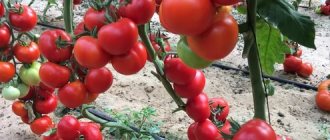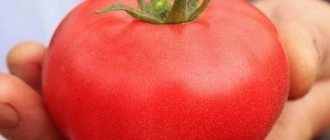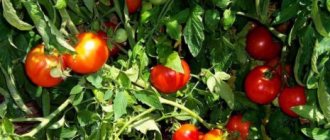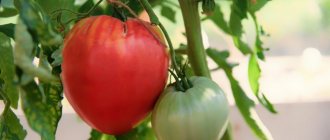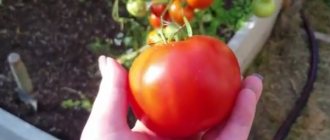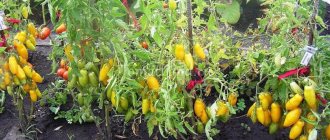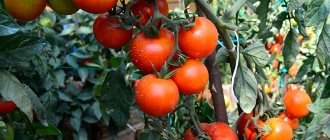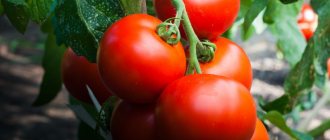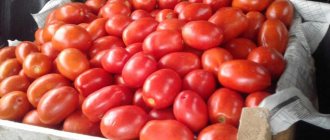The Puzata Khata tomato, first of all, attracts attention with its unusual name. The modern number of tomato varieties allows vegetable growers to choose the one that could satisfy all requirements. In addition to the original name, the Puzata Khata tomato has decent characteristics and a non-standard appearance of the fruit. Description of the variety and reviews from farmers are the main source of useful information that you should rely on when choosing a variety for planting.
The variety is a godsend for lovers of unusual tomatoes
History of variety development
This tomato was bred by breeders from the agricultural sector, which retained the copyright to it. This tomato was included in the Russian State Register and is recommended for cultivation in most regions of Russia in garden beds, as well as in greenhouse conditions.
This tomato was bred in 2012, and the very next year it was included in the Russian State Register and recommended for cultivation in private backyards. However, thanks to the good yield and long shelf life of the fruit, the Puzata Khata tomato is also grown on an industrial scale for further sale.
Varietal characteristics
The size of the bushes is average, the height, depending on growing conditions, ranges from 1.5 to 2 meters. The plant is well leafy, with dark green leaves. Inflorescences are intermediate.
The fruits are round-pear-shaped, with an average weight of about 250 grams, collected in clusters of 3-4 pieces. Tomatoes are characterized by pronounced ribbing. The interesting shape and large size of the tomatoes became the reason for such an original name. The fruit resembles a pot-bellied, bloated hut with clear ribs - the corners of the walls.
The color of the fruit is dark red, the pulp has a rich tomato taste, juicy. The high sugar content makes it possible to include fruits in children's menus. Tomatoes are suitable for canning when cut. More often used in fresh salads.
The yield, subject to agricultural technology, is about 11 kg per square meter.
The variety has a number of advantages:
- excellent taste;
- high yield rates;
- excellent resistance to temperature fluctuations.
According to reviews from those who grew it, no significant deficiencies were identified in the variety. Its photo and description are widely distributed on specialized forums for summer residents. Most of the reviews from those who planted are positive.
Description of tomato
This tomato variety belongs to the indeterminate type, so if you do not pinch the tops of the central shoots, the plant growth will be unlimited. Usually, the height of the shoots is normalized, not allowing the bushes to grow more than 2 m. But in open ground, Puzata Khata tomato bushes grow no more than 1.5-1.6 m.
The Puzata Khata tomato variety is early ripening - approximately 3.5 months pass from the moment the first shoots appear until the ripe large fruits are harvested.
The bushes of this variety are quite powerful and tall, the shoots are erect, but not too strong. Therefore, the stems of this tomato need to be tied to strong supports or trellises in several places.
The shoots have medium foliage, the formation of lateral shoots is moderate. The foliage is medium in size, typically tomato-like, elongated, with sharp tips, shiny, dark emerald.
Related article:
7 most productive tomato varieties for growing in open ground and in greenhouses
To get large fruits, Puzata Khata tomato bushes should be formed into a pair of stems, and to get even larger tomatoes, you need to form the tomato into one shoot. This is also done if there is not enough space in the beds, and the bushes of this tomato have to be planted too close to each other (up to 0.4 m).
If the plant is formed into a pair of shoots, then a stepson is left to form the second trunk, which appears above the first inflorescence. Racemose inflorescences are usually formed through a pair of permanent leaves, each of which bears no more than 4 fruits.
This variety got its name due to the unusual shape of ripe tomatoes: the rounded pear-shaped fruits look like a hut, and their ribs look like the corners of such a house. The weight of a ripe fruit is at least 250 g.
The color of the smooth, shiny, dense skin is deep red, the flesh is quite dense and tender, with many seed chambers. The fruits are quite sweet, with a slight sourness, the amount of seed material is moderate.
Ripe tomatoes are not prone to cracking, they can easily withstand transportation over any distance, and have good shelf life.
Advantages and disadvantages of the variety
Puzata Khata, like any type of tomato, has positive characteristics and some disadvantages. The main ones are contained in the description of the variety; the rest are determined experimentally by farmers during cultivation.
Even the appearance of the variety’s bushes attracts attention and creates a desire to grow it again
pros
- high yield;
- resistance to temperature fluctuations;
- good taste characteristics;
- nutritional composition of tomatoes;
- ability to carry transportation over long distances;
- ripening of fruits harvested at the stage of technical ripeness;
- resistance to nightshade diseases;
- large fruit;
- keeping quality.
Minuses
- the need to form and tie up plants;
- obligatory stepsoning;
- Tomato demands on soil composition and fertilizing schedule.
The Pot-bellied Hut has much more advantages. Therefore, lovers of unusual tomatoes are happy to grow the variety on their plots.
Diseases and pests
The Puzata Khata tomato is highly resistant to most diseases, including late blight, rot and cladosporiosis. And if tomato bushes get sick, it is due to improper care.
But even if all agrotechnical rules for caring for these tomatoes are observed, this does not save the Puzata Khata tomato from the appearance of pests on it under unfavorable weather conditions. Most often, this tomato variety is affected by aphids or whiteflies. These pests can be controlled using insecticides such as Commander or Aktara.
Productivity
The Puzata Khata tomato is a fairly productive variety. By following all the rules of agricultural technology, you can collect up to 5 kg of fruit from one bush. When planting 1 sq. m. of three plants, the yield will be about 15 kg of high-quality tomatoes.
When growing this variety in greenhouse conditions, large fruits can be expected. When planted in open ground, the tomatoes will be much smaller.
Main pros and cons
The main advantages of the Puzata Khata tomato include:
- Usually the yield of this variety is up to 11 kg, which is an excellent indicator, but vegetable growers say that if you provide the plants with good care and constantly apply fertilizers, you can get more fruits from this variety;
- ripe fruits contain a large amount of vitamins and minerals, as well as too low acid content;
- The harvested crop has good keeping quality. And if the fruits are picked unripe, they ripen well in a dark room. Therefore, they are grown on an industrial scale;
- large-fruited and original shape of ripe tomatoes;
- high resistance to most diseases.
However, the Puzata Khata tomato also has a number of disadvantages , the most significant of which are:
- Mandatory formation of bushes is required, as well as tying tall shoots to strong supports;
- demands on the soil and its composition.
Related article:
Tomato variety Children's sweetness
Growing seedlings
The first true leaves appear 10-12 days after planting the seeds. After 1-2 such leaves appear, the seedlings must be pruned. Each seedling is planted in a separate container or a larger box. Immediately after picking, seedlings should not be placed in the sun. It takes time to adapt.
Only after the seedlings have become stronger is fertilizer applied. It can be humate or urea, but strictly according to the instructions.
Seedlings are grown in two ways:
- In boxes, adding earth. The seedlings are hardened off. To do this, the boxes are taken to cool rooms or outside.
- In a greenhouse. If the frosts are over and there is a possibility, then the seedlings are planted in a closed and insulated greenhouse. This way the seedlings become stronger, have a strong root system and suffer less pain when planted in open ground.
Nuances of planting and care
This tomato variety is grown in seedlings. In this case, seed material is planted for seedlings approximately 55-60 days before the intended transplantation of seedlings to a permanent place.
You can use both purchased seeds and those collected from garden beds for planting. In the latter case, before planting, the seeds should be kept in a weak solution of potassium permanganate for half an hour for pickling.
For planting tomatoes, it is better to use containers with a side height of about 20 cm. The soil mixture can be purchased at a gardening store or prepared yourself. To do this, take humus, sand and leaf soil in equal parts.
After planting the seed, the containers are covered with polyethylene and placed in a warm, dark place. Usually seeds germinate within 4-6 days after sowing.
Then the polyethylene is removed and the containers are transferred to well-lit window sills. Approximately 1.5 weeks after the sprouts appear, they should be fed with complex mineral fertilizer or humate solution.
When the first true leaves appear on the seedlings, they should be transplanted into separate containers. Transplanted plants should be removed for a week in partial shade so that the seedlings are not exposed to direct sunlight. After the picked seedlings have acclimatized, they are again fed with nitrogen-containing fertilizers such as urea or humate.
By the time the seedlings are transplanted into garden beds, the plants should have at least 4 true leaves and ovaries of flower clusters. At the same time, the seedlings must be hardened - they had to be taken out into fresh air for 10-12 days, first for half an hour, and then the time the plants spent outside was gradually increased.
Related article:
Grandfather's recipe for tomatoes
After the plants are transplanted to a permanent place, they should be shaped. This tomato variety is usually grown with a single stem. In this case, all stepsons on the central stem are removed. If Puzata Khata tomato bushes are formed into two stems, then the first stepson is left, from which the second shoot will grow. The remaining stepsons on such bushes must also be removed.
Important ! If pinching is not carried out, then a large number of lateral stems grow on the bushes of this variety. Therefore, too many fruits are formed on the bushes, which will be smaller and take longer to ripen.
This tomato should be watered regularly and moderately. It is especially important to water the bushes in a timely manner at the time of flowering and the appearance of ovaries. If there is too little watering at this time, the flowers and ovaries may fall off.
Therefore, the regularity of watering should be approximately once every 6-8 days, with 5 liters of water added to each bush.
To ensure that moisture evaporates more slowly, after each watering you should mulch the root zone of tomato bushes with straw or peat.
After tomatoes of this variety begin to actively ripen, the amount of watering should be sharply reduced, since excess moisture will lead to cracking.
As tomatoes of this variety grow, they should be fed several times with fertilizers containing potassium and phosphorus. They should be applied before flowering, at the time of ovary formation and at the time of active fruit ripening.
Related article:
Abakan pink tomato - description and characteristics of a mid-early variety
Sowing seedlings
Cultivation of the variety is carried out by seedlings. Can be propagated by seeds obtained from grown fruits. This will not change the characteristics, since the variety is not a hybrid. However, the seeds are small enough to select and save until the next harvest yourself. Most often, gardeners use purchased ones.
Before planting seedlings, the seeds are soaked in water. It is possible to soak them in a growth stimulant to speed up germination.
Seeds are sown in wooden or plastic boxes with a side height of at least 20 cm. You can use ready-made store-bought soil or prepare a mixture of sand, leaf soil and humus.
Seeds are placed in the soil to a depth of no more than 0.5 cm. Deeper planting delays germination time.
After planting, the soil is watered with warm water and covered with cling film. Greenhouse conditions are created in which seeds germinate quickly.
3 days after sowing, the first shoots appear. Germination is good - 95%. This indicator is confirmed by the reviews left by gardeners.
After the shoots appear, the film is removed and the box is transferred to a warm, well-lit place.
For growing in a greenhouse, seedlings are sown at the end of February - early March, for soil - at the end of March - beginning of April.
Stepping and shaping
After the sprouts have taken root in the new place, you can begin to form bushes. To do this, once a week you should remove the stepsons using scissors or manually. It is very important not to confuse stepchildren with flower clusters.
In the first case, they grow from leaf axils, in the second - from the stem. No more than eight flower clusters can be left on one bush, and the bush can consist of one or two stems. Farmers recommend hilling the bushes so that they do not lose moisture, and also tying the stems to pre-installed supports in a timely manner.
Useful video
In conclusion, we suggest watching a video about the Puzata Khata variety.
In the table below you will find links to tomato varieties with different ripening periods:
| Early ripening | Mid-late | Mid-early |
| Pink fleshy | Yellow banana | Pink King F1 |
| Ob domes | Titanium | Babushkin |
| King of the Early | Slot F1 | Cardinal |
| Red Dome | gold fish | Siberian miracle |
| Soyuz 8 | Raspberry miracle | Bear Paw |
| Red icicle | De Barao red | Bells of Russia |
| Honey cream | De Barao black | Lev Tolstoy |
Landing in the ground
By the time the Puzata Hata tomato seedlings reach two months of age, the planting site is ready. And they choose it in advance, taking into account crop rotation. Cabbage beds, planting salad greens, onion and garlic crops are the best option for nightshades. All risks are mitigated by green manure. And in greenhouses, the optimal rotation is with borage.
Site preparation
Puzatu khatu, like other varieties for soil cultivation, is planted in open sunny places. In the fall, a suitable place is looked for and after the previous harvest is harvested, the land is prepared as follows:
- remove crop residues;
- for deep digging - organic matter: humus, compost, rotted manure;
- loosening and leveling with a rake.
Planting green manure on ready-made beds (in a greenhouse or in a greenhouse) before winter will clear the area of pests, reduce the growth of weeds in the spring, and saturate the soil with nutrients.
If the preparation falls in the spring, then no later than a couple of weeks before transferring the seedlings, work with the soil is completed. The soil will settle during this time. Immediately before planting, the soil is spilled with hot potassium permanganate or fungicide.
Disembarkation
For Puzata Khata, the holes are cut so that there is 40 cm between the roots. This is the minimum. There are up to 3 bushes per meter of planting area. If space is limited, the holes are cut in a checkerboard pattern. The depth is measured according to the height of the pots.
Before loading the seedling:
- the ground is dusted with ash;
- a spoonful of mineral complex fertilizers for the spring period or a universal balanced fertilizer is thrown onto the bottom;
- water with warm water;
- Stir lightly after the water has left.
Seedlings are placed in two ways:
- Those that are too elongated are placed with the crown against the wall of the greenhouse or the edge of the bed.
- Short, strong ones - vertically, as is usually done with other plants.
Important ! The bottom pair of leaves is removed immediately upon planting. Deepen down to the first lower leaves. Tomatoes grow roots well along the entire length of the trunk sprinkled with soil.
Puzata Khata seedlings are watered and protected from the scorching rays of the sun. This makes it easier for plants to adapt and take root.
Shelter - newspapers, agrofibre on arches. During the first weeks in open ground, tomatoes are protected from night cold. To do this, the beds are hidden under covering material at the slightest risk.
Reviews
Reviews from farmers about the Puzata Khata variety are somewhat contradictory: some praise the culture for its unpretentiousness in care, others are dissatisfied with the need for frequent feeding and the inexpressive taste of the fruit.
Irina, Krasny Yar, Astrakhan region : “My mother shared Puzata Khata tomato seedlings with me. I planted several bushes in the garden. The variety is productive (9 kg per square meter was harvested), the fruits are large, fleshy, sweet, without sourness. The culture loves moderate watering and fertilizers. If you follow the rules of agricultural technology, you can get a decent harvest. I heard a lot of negative reviews that the fruits grew small and tasteless. From my own experience I was convinced that everything depends on the fertility of the soil.”
Ivan, Lipetsk: “We had experience growing the variety in a greenhouse the year before last. I didn't like the tomatoes at all. The color is some kind of orange, the flesh is dry, there are a lot of empty spaces inside. I tried to marinate it for the winter but failed. The banks exploded without standing for even a month.”
Ulyana, Vyksa, Nizhny Novgorod region: “I have been growing these wonderful tomatoes for three years in a row in a greenhouse. To achieve abundant fruiting, I advise you not to skimp on fertilizers. I use chicken manure and ready-made mineral complexes with potassium, magnesium, and phosphorus. I water it once a week and sprinkle the soil with sawdust. The variety does not suffer from late blight and viral diseases, which greatly simplifies care. Puzzle tomatoes are very tasty, sweet, and have an interesting ribbed shape.”
